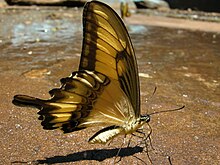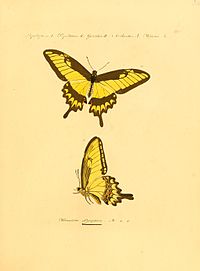| Papilio astyalus | |
|---|---|

| |
| Mounted specimen on display at Museo di Scienze Naturali Enrico Caffi, Bergamo Female | |

| |
| Conservation status | |
 Least Concern (IUCN 3.1) | |
| Scientific classification | |
| Domain: | Eukaryota |
| Kingdom: | Animalia |
| Phylum: | Arthropoda |
| Class: | Insecta |
| Order: | Lepidoptera |
| Family: | Papilionidae |
| Genus: | Papilio |
| Species: | P. astyalus |
| Binomial name | |
| Papilio astyalus Godart, 1819 | |
| Synonyms | |
| |
Papilio astyalus, the broad-banded swallowtail or Astyalus swallowtail, is a butterfly of the family Papilionidae. It is found from Mexico south to Argentina. It is occasionally reported from southern Texas and rare strays can be found up to southern Arizona and northern Texas.

The wingspan is 117–120 mm. In the male the wings are black, on the obverse the forewings are crossed by a wide yellow band crossed by black veins. There is a small yellow macula in the cell and a series of yellow macules in the submarginal part. The hindwings bear tails, a yellow band in the extension of that of the forewings, submarginal yellow macules, and an orange-red ocellus surmounted by an iridescent blue lunule in the anal angle. On the reverse the wings have similar patterns but the cell of the fore wings is striped with yellow and the black part of the hind wings is smaller. The hindwings also bear a series of iridescent blue lunules surmounted by orange-red lunules.
The female is darker, and lacks the broad yellow band present in the male. On the obverse the forewings are dark brown, paler in the submarginal part and bear a series of submarginal yellow macules. The hindwings are dark brown with a series of submarginal red, iridescent blue and yellow macules, an orange ocellus in the anal angle and more reduced tails. The reverse is similar, but the blue spots are more reduced and are surmounted by orange-red lunules.
Male has yellow body below and flanks but black above, female has black body.Very similar to Papilio thersites.
Adults are on wing from April to October. There are probably two generations per year.
The larvae feed on the leaves of Citrus trees. Adults feed on the nectar of various flowers, including Lantana species.
Subspecies
- P. a. astyalus (Brazil (Rio Grande do Sul, São Paulo, Minas Gerais, Parana), Argentina, Paraguay)
- P. a. pallas Gray, (Texas, Mexico, Costa Rica)
- P. a. bajaensis Brown & Faulkner, 1992 (Mexico (Baja California Sur))
- P. a. hippomedon (C. & R. Felder, 1859) (Colombia, Venezuela)
- P. a. phanias Rothschild & Jordan, 1906 (Ecuador, Peru, Bolivia, Goias)
- P. a. anchicayaensis Constantino, Le Crom & Salazar, 2002 (Colombia)
Biogeographic realm
References
- Puttick, A.; Rosa, A.; Mega, N.; Marini-Filho, O.; Freitas, A.V.L. (2020). "Papilio astyalus". IUCN Red List of Threatened Species. 2020: e.T122524195A122602841. doi:10.2305/IUCN.UK.2020-2.RLTS.T122524195A122602841.en. Retrieved 5 December 2022.
- Jean-Baptiste Godart, Encyclopédie méthodique : Histoire naturelle, Paris, chez Panckoucke, 1819
- Lewis, H. L., 1974 Butterflies of the World ISBN 0-245-52097-X Page 25, figure 6
External links
- Collins, N. Mark; Morris, Michael G. (1985). Threatened Swallowtail Butterflies of the World: The IUCN Red Data Book. Gland & Cambridge: IUCN. ISBN 978-2-88032-603-6 – via Biodiversity Heritage Library.
- nearctica.com
- Butterflycorner Images from Naturhistorisches Museum Wien
| Taxon identifiers | |
|---|---|
| Papilio astyalus |
|
This Papilionidae-related article is a stub. You can help Misplaced Pages by expanding it. |
- IUCN Red List least concern species
- Papilio
- Butterflies of Central America
- Papilionidae of South America
- Butterflies described in 1819
- Lepidoptera of Mexico
- Taxa named by Jean-Baptiste Godart
- Lepidoptera of the United States
- Lepidoptera of Argentina
- Lepidoptera of Brazil
- Lepidoptera of Colombia
- Lepidoptera of Venezuela
- Lepidoptera of Ecuador
- Lepidoptera of Peru
- Lepidoptera of Bolivia
- Fauna of Costa Rica
- Papilionidae stubs